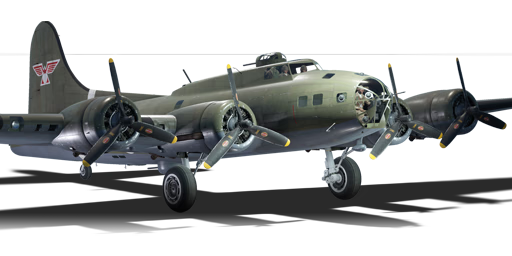



This B-17E, most likely B-17E 41-2471, was one of the few B-17 (D/E) Flying Fortresses that the Japanese captured during World War II, mostly from the Philippines and Java. They repaired and tested some of them. The crew of the B-17E 41-2471, which belonged to the 7th Bomb Group of the USAAF, abandoned it after a crash landing on 8 February 1942 at Djokjakarta, Java. The Japanese found it mostly intact and repaired it with parts from other damaged B-17Es. They flew it to Tachikawa Airfield near Tokyo, where they used it for research and training purposes. The B-17’s final fate is unknown, but it was probably destroyed by Allied bombing raids or scrapped after the war.
Introduced in Update 1.43, the B-17E Flying Fortress, as the name suggests, is intended to be used as a high-altitude level bomber, designed to target enemy airfields, military bases, factories and other infrastructure crucial to winning the war. Despite its large bomb load, it is not recommended to target moving ground targets, such as tank formations, unless they are the only targets. This is because of the inaccuracy of the bombs at such high altitude, and since columns will simply disperse when they sight bombs falling. When using the B-17E, it is always best to group up with others in a wedge-like formation for optimal defence against air targets and climb to an altitude of at least 4,000 m. A few fighter escorts would ensure the survival of friendly bombers, only if they adopt fighter-sweep tactics to hunt down enemy fighters converging on the formation.
flaps
flaps
flaps
brake
| Belt | Belt filling | Armor penetration (mm) at a distance: | |||||
|---|---|---|---|---|---|---|---|
| 10 m | 100 m | 500 m | 1000 m | 1500 m | 2000 m | ||
| T/AP/I/AP-I | 30 | 27 | 20 | 13 | 9 | 6 | |
| AP/AP/AP/T | 30 | 27 | 20 | 13 | 9 | 6 | |
| AP-I/AP-I/AP-I/T | 28 | 26 | 18 | 11 | 7 | 4 | |
| Belt | Belt filling | Armor penetration (mm) at a distance: | |||||
|---|---|---|---|---|---|---|---|
| 10 m | 100 m | 500 m | 1000 m | 1500 m | 2000 m | ||
| T/AP/I/AP-I | 30 | 27 | 20 | 13 | 9 | 6 | |
| AP/AP/AP/T | 30 | 27 | 20 | 13 | 9 | 6 | |
| AP-I/AP-I/AP-I/T | 28 | 26 | 18 | 11 | 7 | 4 | |
| Belt | Belt filling | Armor penetration (mm) at a distance: | |||||
|---|---|---|---|---|---|---|---|
| 10 m | 100 m | 500 m | 1000 m | 1500 m | 2000 m | ||
| T/Ball/Ball/AP/I | 13 | 12 | 7 | 3 | 2 | 0 | |
| T/AP/AP/AP/I | 13 | 12 | 7 | 3 | 2 | 0 | |







 2 x (115 / 270 / 500) %
2 x (115 / 270 / 500) % 
 2 x 166 %
2 x 166 % 

Flight performance | |
|---|---|
Survivability |
|---|
Weaponry | |
|---|---|